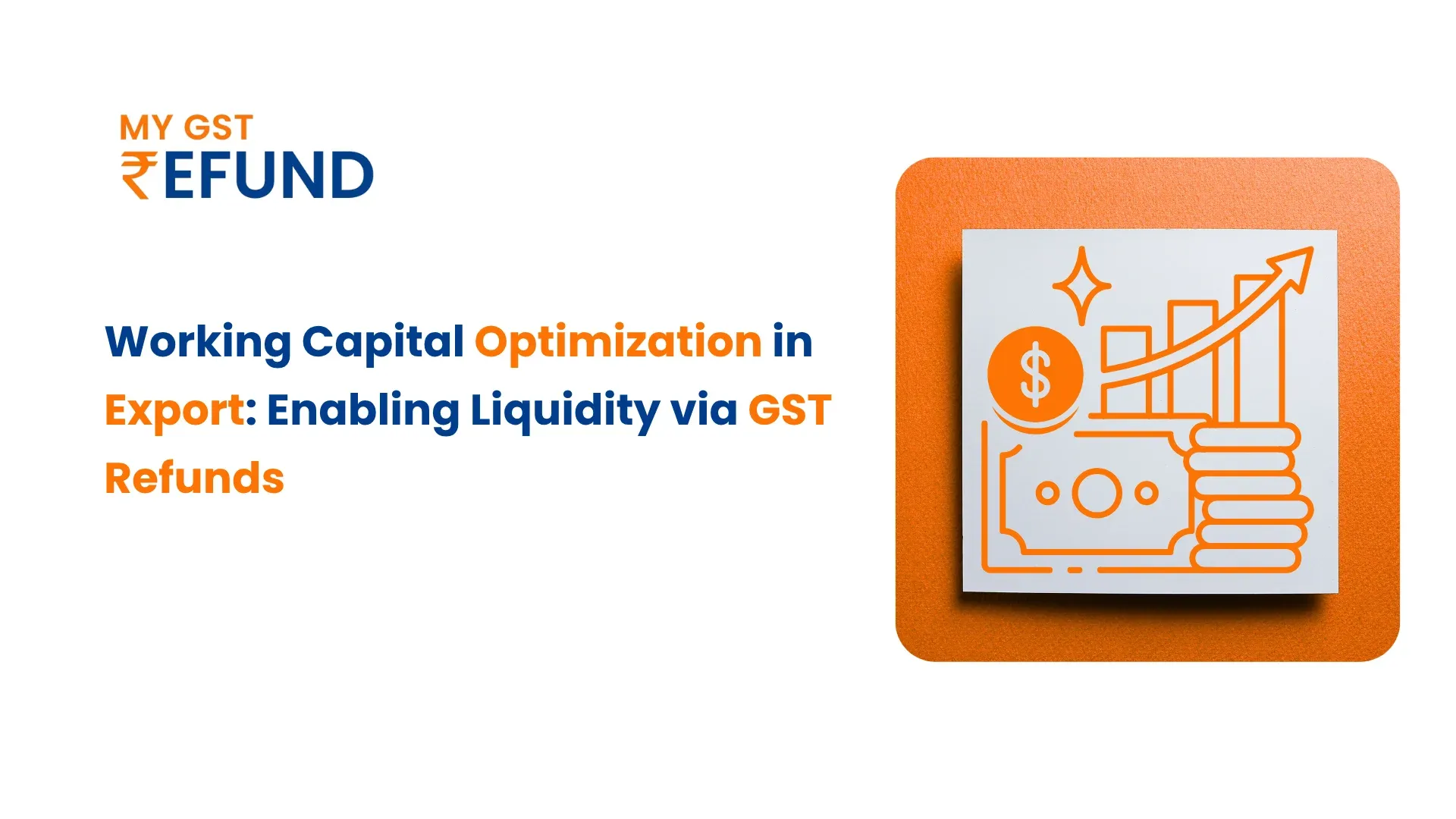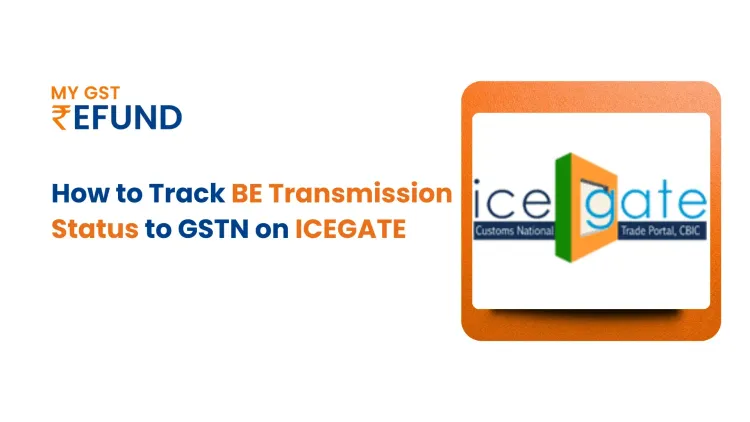What is Working Capital Optimization in Export: Unlocking Liquidity via GST Refunds
Liquidity is the blood of global trade as far as exporters are concerned. The ability to work the money efficiently through the export cycle, from the procurement of raw materials to the payment of final invoices, is what will determine success or failure. However, there are numerous exporters who face issues with delayed Export GST Refunds, IGST Refunds, or capital that is frozen in the customs clearance system. These issues directly affect the efficiency of operations and competitiveness in the world.
There, the Export Working Capital Optimization comes in. Managing cash is not simply taking money and spending it efficiently, but rather making optimal use of financial nimbleness that will enable businesses to accommodate more orders, invest in technologies, and operate internationally without any form of liquidity restrictions. Here in this blog, we will discuss the maximisation of working capital in export and the strategies that are essential for it.
What is Export Working Capital Optimisation?
Export Working Capital is the short-term capital required to finance export business, such as production, transportation, insurance, customs, and payment. Exports usually have long payment periods, and hence working capital becomes tied up in documentation, the tax system, and the remittance processes in the foreign country.
Working Capital Optimization in Exports refers to the optimization of the flow of funds in this cycle by eliminating the idle capital, accelerating the flow of funds back, and balancing the receivables and payables. The objective is not complicated; it is cash flow optimisation in export, such that the rupee invested in it gets back to the business quicker.
An export working capital consists of the following main elements:
Pre-shipment finance- money utilized in the buying of raw materials, packaging, and production.
After-sales finance- credit that is issued until the realization of payment by foreign consumers.
GST and IGST Refunds: This is the tax paid when exporting and is refundable to inject cash into the economy.
Receivables management - effects of management of export invoices and collections.
Exporters will experience financial stress decreased by maximizing all these aspects and investing in new export opportunities.
Why is Optimizing Export Working Capital Important?
The exporters encounter different financial issues compared to local enterprises. Liquidity gaps may be caused by long credit terms, fluctuations in currencies, and remittances that are held up. Unproductive Export Working Capital management may cause production, shipment, and global opportunity disruptions.
The reason is as follows: Working Capital Optimization in Exports is crucial:
Enhances Cash Flow: Faster IGST Refunds and faster realization of receivables will provide healthy liquidity.
Minimizes the Cost of Borrowing: When managed effectively, the cost of financing becomes less, as less use is made of expensive costs.
Increases Export Competitiveness: Exporters are able to price better and suit the demand internationally on time with an optimized working capital.
Maintains Regulatory Compliance: Appropriate monitoring of Export GST Refunds, documentation, and the custom treatment will mean easy audit and no penalty.
Enables Business Scalability: Optimistic cash flow enables the exporters to accept bigger orders without experiencing financial pressures.
Succinctly, cash flow optimization in export converts a rather reactive financial model to an active growth facilitator.
Key Strategies to Optimize Working Capital in Exporting
To maximise export working capital, there should be a mix of financial planning, automation, and regulatory compliance. The following are practical methods of maximizing working capital in the export business:
1. Quicken GST and IGST Refunds.
A big share of the exporter's money is trapped in the form of tax. It is very important to apply the appropriate category of the refund, either payment of IGST or under the LUT (Letter of Undertaking).
2. Optimize Customs and Paperwork.
Delays that are customarily bound to capital and inventory. By converting export paperwork, adhering to customs procedures, and real-time tracking of the shipment, the time spent getting clearance may be reduced, thereby releasing funds sooner.
3. Effective Receivables Management.
Strong credit policies, trade financing tools such as export factoring, and follow-ups with buyers should be undertaken in good time. Live invoice and payment tracking make the money move as expectedly.
4. Maximize Inventory Management.
Excessive inventory is a waste of capital. Data-driven forecasting tools enable exporters to hold lean inventories without upsetting the production schedules.
5. Take Advantage of Export Financing.
Export financing solutions are now provided by banks and fintech platforms. Any liquidity gaps can be bridged by short-term working capital loans, pre-shipment and post-shipment credits, as well as by export bill discounting.
6. Automatize Accounting and Reconciliation.
The reconciliation between GSTR-1, GSTR-3B, and export invoices is automated to eliminate any errors in the process and ensure that Export GST Refunds are performed correctly and that the claims are not held up.
The above strategies can thus help the exporters to improve working capital optimization in their exports, minimise reliance on external credit, and have a healthy cash flow.
The Role of Technology and Automation in Export Working Capital
Technology is changing the way exporters are able to deal with funds, compliance, and refunds. Automation removes human bottlenecks, improves accuracy, and fastens all financial procedures in the exporting cycle.
Automation is advantageous in maximizing working capital in export in the following way:
- Automated Reconciliation: Compares invoices, IGST Refunds, and FIRA in real time.
- Smart Dashboards: Gives a 360-degree perspective of cash flow, status of refunds, and pending documents.
- AI-powered Alerts: Inform exporters of missing invoices, defaults, or refusals of refunds.
- Quick Compliance: Combined with the GSTN and custom information to prevent discrepancies or duplication of entries.
- Refund Analytics: Monitors the refund timeframes, determines bottlenecks, and recommends optimization activities.
Under automation, exporters can attain optimization of cash flow in export and cut down on refund turnaround times and the accuracy of GST filings and compliance records.
How Export Working Capital Optimization Drives Business Growth
Maximizing the working capital not only makes liquidity a better situation, but it also has an effect on the business performance. Those exporters who manage their working capital well have a chance to reinvest their profits into R&D, enter new markets, and expand their operations worldwide.
Here’s how it impacts growth:
- Liquidity to Grow: Releasing the revenue of refunds and compliance delays provides exporters with the level of flexibility to increase production and reach.
- Higher Profit Margins: The cost of money is reduced, resulting in higher profit retention.
- Increased Credibility: Timely compliance develops trust with banks, partners, and international customers.
- Risk Reduction: Well-organised capital cycles decrease the reliance on outside borrowing and minimize the risks of currency.
Financial agility is a firm-cutting-edge in a competitive export market. Exporters that focus on export working capital maximization are putting themselves in a position of sustainable growth in the global arena.
MYGST Refund: Powering Exporter Liquidity
MYGST Refund empowers exporters with fast, transparent, and flexible Export GST Refund & IGST Refund solutions. Our platform simplifies the refund process, improves cash flow and working capital through legal compliance, and helps exporters run their global operations smoothly and efficiently.
Schedule a free consultation today and learn how MYGST Refund can help you grow your export faster.
Conclusion
Financial efficiency is something that will determine the competitiveness of global trade in 2025. By concentrating on working capital maximization when exporting, the exporters are guaranteed of liquidity, as well as enhancing their growth prospects in the long run. Optimization of cash flow in exports, payment of IGST timely, and electronic clearance of customs is not an option anymore, but a strategic need.
Frequently Used Questions (FAQs)
1. What then is working capital optimization in export?
It is the control of short-term funds in the export operations through balancing between the receivables, payables, and refunds. This is aimed at enhancing liquidity, decreasing borrowing, and making sure it is financially healthy.
2. What are the effects of GST and IGST refunds on the liquidity of exporters?
Refunds aid in the release of funds trapped in taxes. Rapid processing of Export GST Refund and IGST Refund would mean optimization of cash flows in export and lower working capital pressure.
3. What is the role of export finance in cash flow management?
Export finance provides liquidity as post-shipment and pre-shipment credit, bill discounting, and factoring, which assist exporters to close the gap between the shipment and the realization of payment.
4. What can the technology do to assist exporters in handling working capital?
Automation tools improve the reconciliation, compliance, and tracking of refunds, decreasing the number of manual errors and enhancing the availability of funds to conduct operations.
5. What are the most important advantages of the optimization of export working capital?
It supplies increased liquidity, lowers expenses, assists exporters in growing internationally without interruptions in finances, and enables them to make their decisions in time.
Related Posts






